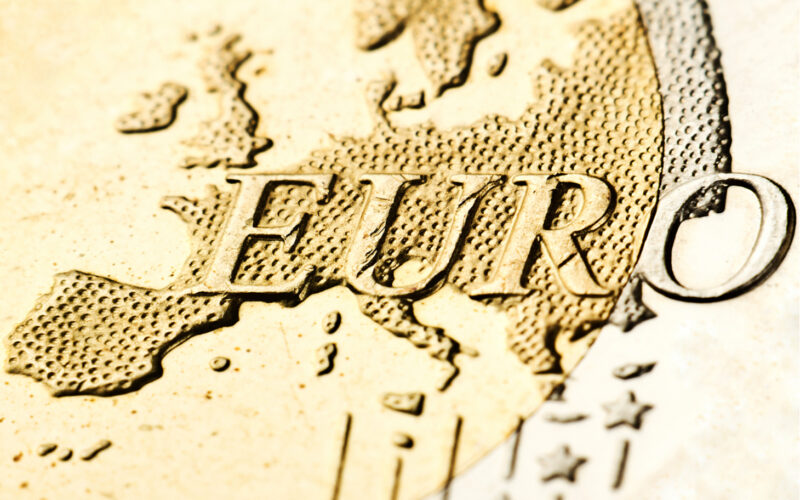While the European Central Bank (ECB) has backstopped the governments of the weaker euro area economies, and thereby their banks, it hasn’t been able to prevent ongoing capital flight within the euro area. Deposits have consistently fled peripheral countries’ banks for those in jurisdictions deemed safer, such as Germany. This is clearly visible in the so-called “TARGET2” balances.
But, what is TARGET2?
The “Trans-European Automated Real-time Gross Settlement Express Transfer System” as it is more formally known, is the euro area internal accounting measure of what the various member national central banks owe one another. As explained more thoroughly by the Economics Department of the German University of Osnabrück:
TARGET2 records claims and liabilities of national central banks, as well as the ECB, against the Eurosystem. A country’s TARGET2 balance is affected by its surpluses/deficits in (i) the current account, (ii) the financial account, and/or (iii) the capital account. It is reminiscent of a swap line operation or a change in foreign reserves under a fixed exchange rate arrangement.
The German Bundesbank, and to some extent even the Banque centrale du Luxembourg (BCL), are large net creditors to the Italian, Spanish, Greek and Portuguese central banks. As it stands now, the Bundesbank has extended over €1 trillion in credit and the BCL some €250 billion.
This means the Italian, Spanish, Greek and Portuguese central banks owe the German and Luxembourg central banks an enormous amount of money. Note that this is debt that doesn’t show up on their respective governments’ balance sheets, but which is nevertheless being incurred and growing over time.
Not that there’s a shortage of the usual debt…
The debt hangover that won’t go away
Alongside the growth in TARGET2 imbalances, Italian, Spanish, Greek and Portuguese government debt continues to pile up, and France is rapidly catching up in the race away from fiscal rectitude.
Total general government debt in Italy and Portugal has risen to around 130% of national GDP as of Q4 2020. Elsewhere, the figures are 120% in Spain and a staggering 205% in Greece. But France is now closing in on 116% following several years of generally poor growth.
Germany’s debt has held relatively stable by contrast and now stands at just under 70% of GDP. That is still a large figure in a historical comparison, but few doubt Germany’s ability to service that debt, given that its economy remains so competitive. The same cannot be said of the higher-debt countries above.
The situation is only set to get even worse as the peripheral euro economies chronically underperform. As noted by prominent German economist Hans-Werner Sinn:
[T]he eurozone remains internally unbalanced. This also becomes apparent if one looks at manufacturing output in Southern Europe. Unlike domestic sectors, the region’s manufacturers must compete internationally, and therefore have suffered the most from high relative prices. Even before the coronavirus crisis, manufacturing output in Italy was 19 per cent below its level in the autumn of 2007, just before the real economy reacted to the financial crisis; in Spain, it was 21 per cent lower. The downward trend has continued during the pandemic, widening the output gaps to 35 per cent and 34 per cent, respectively.
The new EU recovery fund is meant to address this fiasco, but money cannot solve the problem of distorted relative goods prices within the eurozone. Fixing it requires an open or real devaluation. But no one wants to talk about that. Instead, the EU’s strategy seems to be based on hope and prayer.
Given this situation, how is it possible that countries such as Italy or Spain can still borrow at essentially zero interest rates? Well, they have the ECB to thank for that. The Eurosystem’s total holdings of euro-denominated bonds has grown to €4.3 trillion, a disproportionate share of which is holdings of the more indebted euro area members’ bonds. Indeed, the Italian and French government bond markets, each comprising roughly € 2.4 trillion in total, both now exceed the German in overall size, which stands at roughly €2 trillion.
Growing legal challenges
This surge in debt is important because the ECB charter, part of the 1992 Maastricht Treaty which set the Economic and Monetary Union (EMU) in motion, specifies that the ECB’s holdings of euro area government debt should be proportionate, rather than skewed one way or another. A skew which favours one country over another would amount to a de facto form of fiscal policy support by favouring one or more countries over others – with implied lower borrowing costs and generous financing.
But the ECB has been doing this for years and has only accelerated its peripheral bond-buying with the myriad emergency bond purchasing facilities implemented of late, such as the APP and PEPP. It is a policy which has drawn increasing criticism and also legal action before the German Constitutional Court, the Bundesverfassungsgericht in Karlsruhe.
Last year, the Court ruled that the Bundesbank must clarify how it was that its participation in the Eurosystem was compatible with the ECB charter, given that this appeared not to be the case. This was widely interpreted in the press as mostly a slap on the wrist, but popular opposition to seemingly endless German support for the periphery of one form or another continues to rise. The major political parties are on the defensive, with both extreme left and right gaining ground.
Nor is rising populism limited to Germany. Indeed, in Italy, Spain and France, populist politicians have been threatening the older, established parties for years. Marine Le Pen, a long-term Eurosceptic, is now leading incumbent President Emmanuel Macron in the most recent polls.
The fact is, the euro area is at its most politically unstable state in its history, and this even before a wave of inflation rolls in. Soaring global food and energy prices have already hit the United States and the UK, where consumer price inflation has surged to 5% and 2% year over year, respectively. Much more inflation is visible “in the pipeline” through producer prices, whose increases are pushing into the double-digits. It is only a matter of months before this global wave of inflation arrives at the euro area’s politically vulnerable shores.
How will the euro survive?
And so the question must be asked: how is the euro to survive, if the political foundations underneath it continue to erode and the economic imbalances only grow?
The fact is the euro may well not survive long term, but might there be a way in which to restructure it, so as to relieve the growing economic and political pressure on the single currency?
As it happens, some prominent euro area economists have tackled this question and offered a road map for what a general euro restructuring might look like, including Hans-Werner Sinn quoted above. He has proposed a restructuring in his 2012 book, The Euro Trap, and more recently, The Economics of TARGET Balances.
However, as he makes plain, any restructuring or reform of the euro will require a new European Treaty superseding Maastricht: the new treaty will include essentially introducing a fiscal union between members. It is highly doubtful that, in the current political climate, that any attempts to negotiate, draw up and ratify a new general EU Treaty mandating fiscal union could succeed.
Alternatively, were Germany willing to bail out the periphery wholesale, issuing sufficient German government debt into order to do so, they could probably pull it off. But there is just no way that Germans would approve of a no-strings-attached bailout. Rather, Germany would need to acquire ownership and control of peripheral countries’ assets in return.
One wonders what might be on the list: major ports, toll roads, railways, airports, power plants, other national infrastructure… and one must thus wonder how that would go over in the affected countries.
It is really just a political non-starter. And so the euro area is simply stuck in an impasse.
Until, that is, one nation decides to leave. More on that tomorrow…
John Butler
Author, The Golden Revolution, Revisited




